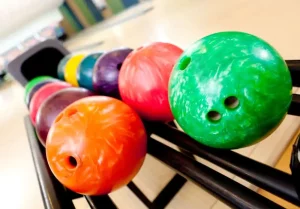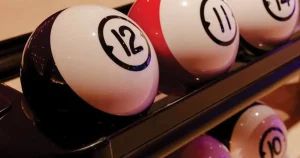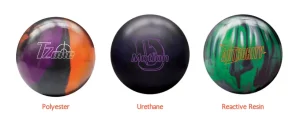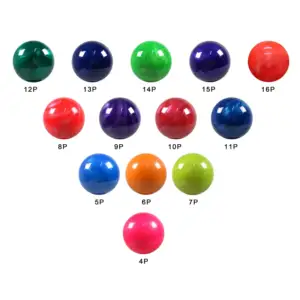If you’re venturing into the world of bowling and aiming for a more professional approach to the game, as opposed to casual recreation, it’s worth delving into the topic of bowling balls.
It may come as a surprise to discover the existence of various types of bowling balls, designed not only to accommodate different hand sizes and shapes but also to cater to different bowling techniques.

When you grasp the intricacies of the bowling ball and its interactions with the various sections of the lane, coupled with an understanding of the underlying physics at play during your throws, you have the potential to elevate your game to new heights. By acquiring this knowledge, you can undoubtedly enhance your skills and make noticeable improvements.
Moreover, knowing the ball allows you to select the one that aligns perfectly with your technique and preferences.
As Ty Webb famously said in the classic film Caddyshack (1980), one must truly embody the essence of the ball.
Contents
What Are House Balls?
Let’s begin with something familiar to us.
When you visit a bowling alley with friends or family, not only do they provide you with shoes, but they also offer a selection of bowling balls. These balls, which are provided by the establishment, are commonly referred to as ‘house balls’. It’s possible that you may not have been aware of this terminology.
Bowling balls in the house are typically categorized by weight and color. As a child, you probably gravitated towards your preferred color or pattern, spending most of your time mesmerized by your journey back up the ball retrieval system.
As you progress in the world of bowling and begin investing in your bowling balls and shoes, you might come across certain inconsistencies or variations that catch your attention.
When it comes to purchasing a bowling ball, weight is often the primary consideration for most house balls. However, there are several other factors to take into account, such as the material, which is typically consistent across house balls.
House balls are often considered the starting point when choosing a bowling ball. Simply finding one that fits your hand well in a general sense can help us understand the various factors to consider when looking for the perfect ball. By optimizing our word choice, and improving the structure and readability, we can enhance the overall quality of the writing while preserving the original meaning.

What To Consider When Buying Your Ball?
As previously mentioned, there are numerous factors to consider when purchasing a bowling ball. It is common for professional bowlers to utilize multiple balls based on the specific conditions or techniques they are employing.
If you find yourself in this situation, it would be wise to contemplate investing in a bowling ball bag to conveniently transport them. After all, lugging around heavy balls is far from enjoyable.
However, if someone jokingly asks, “What do you have in there? Bowling balls?” you will have no choice but to respond affirmatively.
In any case, here’s our comprehensive guide to different bowling balls, highlighting their unique characteristics and how they suit various styles and purposes. Whether you’re a beginner looking for a ball with extra control and forgiveness, or an experienced bowler seeking a high-performance option for precision and power, we’ve got you covered.
Get ready to discover the perfect bowling ball that will take your game to the next level!
A Matter of Fit: To Be Snug or Not?
While experienced individuals may consider it common sense, beginners might overlook the fact that they should be able to effortlessly insert and remove their fingers from the finger holes.
If you discover that your thumb or fingers do not fit comfortably into the finger holes, it is recommended to select a different ball.
This applies not only to house balls but also to your bowling ball. It’s important to keep in mind that the same principles of care and maintenance should be followed for both types of balls to ensure optimal performance and longevity.
If you struggle to release the bowling ball effortlessly from your hand, you risk carrying it down the lane or causing irreparable harm to your hands. Furthermore, it is simply impractical if your goal is to excel at bowling.
Bowling Ball Span Measurement
When purchasing your bowling ball or selecting a house ball, it is important to take into account the span, which primarily serves as a safety and comfort measure. Considering this factor can greatly enhance your overall bowling experience.
The span of the bowling ball will ultimately determine the grip you can achieve and how well it fits your hand.
When you visit a bowling ball store or a bowling alley, they can measure your hand and determine the optimal bowling ball span that will provide the best fit for you.
The term “bowling ball span” commonly refers to the measurement from the thumbhole to the front edges of the two finger holes. This span significantly influences the type of grip you can employ and how effectively you can maintain it. By optimizing the span, you can enhance your grip, control, and overall performance in the bowling alley.
Typically, there are three types of grips used in bowling. The first is the conventional grip, which is the most common way people throw the bowling ball. The second is the semi-fingertip grip, where the grip is only on the second joint of the finger. Lastly, there is the fingertip grip, a more challenging grip often employed by professionals, where only the first joint of the finger is inserted into the hole.
In general, it is important to ensure that your hand does not strain excessively to reach each hole. This can cause discomfort and negatively impact your technique and grip. It is crucial to maintain proper hand positioning and alignment to prevent any potential harm and maintain optimal performance.
Pitches
As a beginner, you may not be familiar with the concept of pitches. Pitches primarily determine how the ball is released from your hand, rather than just focusing on your grip.

When purchasing their personalized ball, many individuals do so to acquire custom pitches tailored specifically to their hands.
In basic terms, pitches refer to the specific angles at which you position your thumb and fingers when inserting them into the finger holes of the ball.
Experienced players with a strong grip often have a thumb hole with a reverse pitch to achieve the best release. This allows for optimal word choice, improved structure, enhanced readability, and eloquence while maintaining the original meaning.
While a forward pitch angle generally enables a longer grip on the bowling ball, it is particularly beneficial for those who have yet to develop a strong grip.
When it comes to the finger holes, a forward pitch provides a better grip for your fingers, while reverse pitches aid in achieving a smoother roll of the ball.
For beginners, it is common to have a thumb hole pitch that is forward and a finger hole pitch that is also forward.
Weight
Weight plays a significant role in the purchase and customization of a bowling ball. It is a crucial factor that demands careful consideration to ensure an optimal choice and enhance performance on the lanes.
If you’re pondering upon the question, “How can I determine the ideal weight for myself?”, fret not, for there exists a simple method to unveil the answer. Surprisingly, this method isn’t solely reliant on your physical strength or height.
For optimal bowling performance, it is recommended that the weight of the bowling ball be around 10% of your body weight, with the maximum weight being 16 pounds – the heaviest option available. This calculation is a straightforward exercise in basic mathematics.
If you weigh around 150 pounds, a 15-pound ball would be an ideal choice for you. However, if you consider yourself to be particularly strong-armed, you might want to consider using a slightly heavier 16-pound ball for an extra challenge.
However, opting for an 8-pound ball would not be suitable in this case. Bowling is all about precision and continuous movement, rather than simply swinging the lightest ball with maximum force.
Certainly, there are some anomalies to consider. When it comes to choosing balls for children, it is generally recommended that they opt for ones weighing between 6 to 14 pounds. This weight range ensures a suitable level of challenge and promotes proper coordination and control during play. By providing this range of options, children can gradually progress and develop their skills while still enjoying the fun and excitement of the game.
Additionally, if you have recently experienced an arm injury or any other physical condition that could potentially impact your grip and arm strength.
Materials
Professional bowlers pay great attention to one of the most important aspects of a bowling ball: their preferred span, weight, and pitch. These factors are crucial to their performance and are carefully considered when choosing the materials for their bowling balls.
When it comes to bowling, the choice of material is something you typically encounter during the game, rather than a decision you can make beforehand.

Professional bowlers carry multiple balls to adapt to well-oiled or poorly-oiled lanes, ensuring they are not caught off guard. In this article, we will explore the most common material choices and their optimal usage to enhance your bowling experience.
Polyester Bowling Balls
These bowling balls are commonly found at bowling alleys, and polyester is the predominant material used for most of the house balls.
This option is suitable for both bowling alleys and beginners, as these plastic balls are frequently the most affordable and perfectly adequate for casual play.
Nevertheless, certain aspects of this material are less than desirable. When you release a polyester ball down the lane, in a well-oiled environment, the plastic ball glides and rolls simultaneously, often achieving excessive speed, surpassing the optimal level.
However, in cases where the bowling lane is dry and lacks regular oiling, which is common in recreational bowling alleys due to the use of plastic bowling balls, these plastic balls can be highly effective. They still offer a good roll and perform well in such dry conditions.
Moreover, cleaning a plastic bowling ball becomes a breeze when dealing with oil. The oily residue that accumulates on the surface of the ball can be easily and swiftly removed, restoring its original shine and smoothness. With just a few simple steps, such as using a specialized bowling ball cleaner and a soft cloth, you can effectively eliminate any traces of oil and ensure optimal performance on the lanes.
Urethane Bowling Balls
If you’re aiming for improved accuracy or seeking to master techniques like curling or hooking, a urethane bowling ball can prove to be an excellent option. Furthermore, for beginners, it serves as the natural progression in skill development.
Plastic balls effortlessly glide over oil without absorbing it, while urethane balls can absorb some oil, making them ideal for well-oiled lanes as they provide better grip. However, they do not absorb as much as other balls, making them more suitable for dry to medium-oiled lanes.
One drawback of urethane balls is their susceptibility to wear and tear. If your ball appears to require sanding or polishing, it is likely in need of maintenance to maximize its performance.
Particle Bowling Balls
This type of ball should be exclusively used by experienced bowlers who possess a keen understanding of oil conditions. Additionally, these bowlers should be adept at efficiently cleaning and polishing their balls during gameplay.
Once you have mastered the art of a captivating hook and experienced its effectiveness, you might consider exploring the use of a particle bowling ball. These balls are renowned for their exceptional hook potential, making them a favored choice among professionals.
Bowling balls are typically dense and feature a thick outer layer that offers excellent friction. Their rough and heavy composition makes them well-suited for well-oiled lanes, but they can be more challenging to use on dry lanes.
Reactive Resin Bowling Balls
A reactive resin bowling ball combines the characteristics of both urethane coverstock and resin particles, resulting in a unique composition.
One of the primary reasons for their usage is among those skilled in the art of hook technique. The interaction between the resin and the lane itself enables them to possess exceptionally strong grips.
The grip enables a more pronounced hook for those who require it, enhancing their overall performance.
In Summary
When it comes to bowling balls, there’s often more than meets the eye. As a beginner, it’s important to understand your preferences for weight, pitch, and span. These factors will guide you in finding the perfect ball that fits your hand size and enhances your game.
To achieve optimal results when choosing the appropriate weight, it is wise to adhere to the 10% rule. This rule advises increasing the weight gradually, by no more than 10% at a time, to prevent muscle strain. If you are uncertain about the ideal weight, consider visiting a specialized bowling ball shop or a local bowling lane. Knowledgeable staff can provide valuable assistance in measuring and selecting the perfect weight tailored to your specific needs. By following these steps, you can ensure that you possess the finest equipment for a delightful and successful bowling experience.
The choice of material is often restricted to professionals who aim to elevate their performance in the game.


Allow me to introduce myself – I’m Eric Wilkinson, a true bowling aficionado. The world of bowling culture has always fascinated me, and I’ve made the exciting decision to share my passion through writing. As I embark on this blogging adventure, my goal is to provide fellow enthusiasts with valuable insights, tips, and captivating stories. Through my blog, I hope to ignite a deeper appreciation for the sport and foster a sense of community among fellow bowlers. Join me on this thrilling journey as we explore the vibrant world of bowling together.
